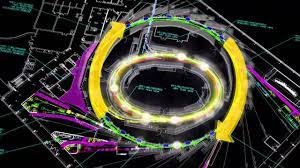Electron Synchrotron, Principle, Construction, Working

Electron Synchrotron
The cyclic particle accelerator in which charged particles are accelerated to high energies in the presence of an alternating electric field while confined to a constant circular orbit by the magnetic field is called an electron synchrotron.
Principle:
Its principle is a combination of the principles of betatron, cyclotron, and phase stability. The resonance is maintained not by varying the frequency of the radio frequency field as done in synchrocyclotrons but by varying the magnetic field such that phase stability maintains the particle energy by keeping it in pace with the energizing field.
Construction:
The electron synchrotron is a doughnut-shaped vacuum chamber in a C-shaped magnet.
Daugnut-shaped accelerator
The pole faces of C-shaped magnets are constructed in such a way that a maximum magnetic field is provided at the center. It is called magnetic focusing. The vacuum chamber is coated with silver from the inside to avoid any hindrance in the operation of the synchrotron due to eddy current. A gap is kept within the coating across which the radio frequency oscillator is used during a proper time. The electrons get accelerated every time they cross the gap when radio frequency is applied across the gap. There are steel bars inside the doughnut which get supersaturated easily. These are provided so that the variation of the magnetic field takes place only for electron orbit. The complete electron synchrotron consists of the electron gun, linear accelerator, boosting ring, storage ring, beamline, and end station.
Working:
Free electrons are created by a heated cathode and are drawn through the gun's end hole by a radio frequency electric field. Then a linear accelerator is used for the preliminary acceleration of electrons up to energies of 50 keV to 100 keV. The linear accelerator feeds these electrons into the booster ring which uses a magnetic field to force the electrons to travel in a circle. The booster ring feeds these electrons into the storage ring which is a many-sided doughnut-shaped tube enclosed in a C-shaped magnet. The electrons attain a velocity comparable to the velocity of light after they are accelerated to high energy. The bars play their role. Once the steel bars get saturated they no longer obey the Faraday law of electromagnetic induction and no EMF is produced. As the electrons gain relativistic speed, the mass of electrons becomes relativistic, and the magnetic field also increases. All electrons can be kept in phase with proper adjustment of frequency. Hence electrons gain energy after every revolution. The magnetic field and orbit radius decide the energy of electrons.
The radio frequency oscillator is turned off when electrons gain maximum energy. A large current is sent through auxiliary coils so that electrons change their orbit due to unstable magnetic flux. These electrons then strike the target from the inner edge of the doughnut chamber. The target releases highly energetic X-rays when electrons strike the target.
The energy of electrons is given as
E = m0c²
as
Where m0c² = 0.51 MeV is the rest mass energy of the electron. The momentum is given
P=E/C……………..-(1)
The magnetic force provides centripetal force to electrons to orbit in a circular path
Fm= Fe
qVB = mV
mV = qBr
P = qBr…………….-(2)
Comparing eq(1) and eq(2)
qBr = E/e
E = qBrc
It shows if we increase the magnetic field, then energy also increases. The frequency of revolution when electrons are at relativistic speeds
f =1/T= w/2π
f= c/2πr
The electron synchrotron is a high-energy accelerating machine while cyclotron and betatron are low-energy accelerating machines.
What's Your Reaction?





















